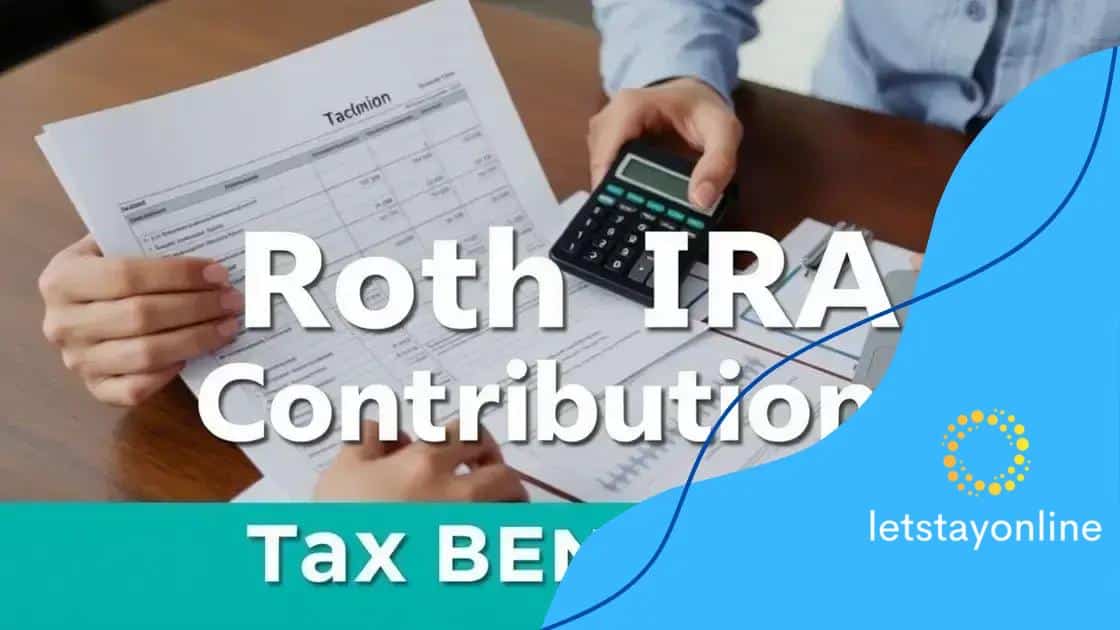Tax advantages of contributing to a Roth IRA

Tax advantages of contributing to a Roth IRA include tax-free growth and withdrawals, allowing individuals to maximize their retirement savings without worrying about future tax liabilities.
Have you considered the tax advantages of contributing to a Roth IRA? This retirement account offers unique benefits that can transform your savings strategy. In this article, we’ll dive into how it works and why it matters.
Understanding Roth IRA basics
Understanding Roth IRA basics is crucial for anyone looking to secure their financial future. A Roth IRA is a special retirement account that allows your money to grow tax-free. Contributions are made with after-tax dollars, which means you pay taxes on the money before it goes into the account. This unique setup provides significant advantages when you withdraw funds during retirement.
Key Features of Roth IRAs
There are several important features to consider when looking at a Roth IRA. These aspects can help you decide if this retirement account is right for you:
- No mandatory withdrawals during your lifetime
- Tax-free growth of your investments
- Your contributions can be withdrawn anytime without penalties
Another point to note is the income limits associated with Roth IRAs. Depending on your filing status and earnings, you may not be eligible to contribute. It’s recommended to check the latest IRS guidelines for any updated limits.
How Contributions Work
When you contribute to a Roth IRA, you’re essentially saving money for retirement that won’t be taxed once you start enjoying it. The annual contribution limits may vary, so staying informed about the maximum amount you can deposit is essential. For many people, making contributions regularly can lead to substantial savings over time.
Additionally, since Roth IRAs are designed to encourage long-term saving, the investments within your account benefit from compounding, which can significantly increase your account’s value.
In conclusion, understanding these Roth IRA basics allows you to make informed decisions about your retirement savings. With tax-free growth and flexibility in withdrawals, it can be a powerful tool for building wealth over the long term. Always consult with a financial advisor to tailor your retirement strategy to your personal financial situation.
Tax benefits of Roth IRA contributions

Understanding the tax benefits of Roth IRA contributions is essential for anyone planning for retirement. One of the main advantages is that contributions are made with after-tax dollars. This means you don’t pay taxes on the money when you withdraw it in retirement, allowing your investments to grow tax-free.
Immediate Tax Benefits
While contributions to a Roth IRA don’t lower your taxable income for the year, they offer significant benefits in the long run. The money you invest can grow without worrying about taxes, which can maximize your retirement funds. This provides a unique opportunity for people looking to build wealth over time.
- Tax-free growth of investments
- No income tax on qualified withdrawals
- Flexibility with contributions and withdrawals
Moreover, with a Roth IRA, you are not forced to take required minimum distributions during your lifetime, unlike traditional IRAs. This feature allows you to keep your money invested for longer, further enhancing its growth potential.
Long-Term Advantages
Over time, the tax advantages of contributing to a Roth IRA can be significant. Imagine having a large sum of money that you can withdraw tax-free. This can make a huge difference in your quality of life during retirement. Furthermore, if you pass the account on to your heirs, they can also benefit from tax-free withdrawals if they follow specific rules.
It’s also important to remember that qualifying for a Roth IRA depends on your income level. Higher earners may need to assess other tax-advantaged accounts to ensure they’re maximizing their savings effectively.
In essence, the tax benefits of Roth IRA contributions create a strategic advantage for retirement savings, enabling individuals to enjoy a more secure financial future.
Eligibility requirements for contributions
Understanding the eligibility requirements for contributions to a Roth IRA is vital for maximizing your retirement savings. Not everyone can contribute directly to a Roth IRA. For most people, eligibility is based on income level and tax filing status.
Income Limits
The ability to contribute to a Roth IRA depends largely on your modified adjusted gross income (MAGI). If your income exceeds certain thresholds, you may have to limit your contributions or may not be eligible to contribute at all. For the current tax year, individuals with a MAGI below a specified limit can contribute the full amount.
- Single taxpayers: The contribution limit phases out as income increases.
- Married couples filing jointly: Higher income limits apply.
- Married individuals filing separately: A much lower income limit applies.
It’s important to regularly check the IRS guidelines as these income limits can change each year. If your income fluctuates, make sure you monitor your eligibility status annually.
Contribution Amounts
The maximum contribution limit for Roth IRAs is also a key factor. The IRS sets a cap on how much you can contribute each year. This amount can be different depending on your age, with individuals over 50 eligible for catch-up contributions. Always consider these limits as part of your retirement strategy.
Remember, contributions can only be made with earned income, meaning you must have a job or self-employment income to qualify. Passive income sources, like dividends or rental income, do not count toward this requirement. Utilizing all these insights will help you make the most of your Roth IRA contributions.
Withdrawal rules and tax implications

Understanding the withdrawal rules and tax implications of a Roth IRA is crucial for effective retirement planning. Knowing how and when you can access your funds can help you avoid unexpected tax consequences.
Qualified Withdrawals
Withdrawals from a Roth IRA can be tax-free if certain conditions are met. You can withdraw your contributions at any time without penalty since you have already paid taxes on that money. However, to withdraw the earnings without taxes or penalties, you must meet two key requirements. First, the account must be at least five years old. Second, you must be at least 59½ years old, or the withdrawal must be due to a qualified exception such as disability.
- Withdraw contributions anytime tax-free
- Withdraw earnings tax-free if conditions are met
- Exceptions for early withdrawals can include disability or first-time home purchase
For example, if you are under 59½ and withdraw earnings, you may face taxes and a 10% penalty. It is essential to consider these rules carefully to avoid unexpected costs.
Roth IRA vs. Traditional IRA Withdrawals
Unlike traditional IRAs, where withdrawals are often taxed as income, Roth IRA withdrawals are unique. Since contributions are made after tax, you avoid additional taxes on qualified distributions. This can be particularly beneficial during retirement when you may be in a higher tax bracket. Understanding this difference allows you to strategize your withdrawals better.
Additionally, if you need to withdraw funds from your Roth IRA before the five-year rule is met, you should be aware of how that impacts your retirement plan. Non-qualified withdrawals of earnings will incur taxes and penalties, it’s essential to keep this in mind as part of your larger financial strategy.
Strategies for maximizing your Roth IRA
Maximizing your Roth IRA can significantly enhance your retirement savings. There are several strategies you can employ to ensure you get the most out of this tax-advantaged account.
Start Early and Contribute Regularly
One of the best strategies is to start contributing to your Roth IRA as early as possible. The power of compound interest means that the earlier you invest, the more your money can grow. Regular contributions, even if they are small, can add up over time. Aim to contribute the maximum amount allowed each year, if your budget permits.
- Set up automatic contributions to ensure consistency.
- Use windfalls or bonuses to boost contributions.
- Adjust contributions annually based on income growth.
Building a habit of regular contributions makes a significant difference in your total savings at retirement. It’s important to treat your Roth IRA contributions as a non-negotiable part of your budget.
Invest Wisely
Choosing the right investments within your Roth IRA can also maximize growth. Consider a diversified portfolio that includes stocks, bonds, and mutual funds tailored to your risk tolerance and retirement timeline. A well-balanced portfolio can yield higher returns over the long term.
As you approach retirement, gradually shifting your investments to more stable options can safeguard your savings. Regularly review your investment strategy to adjust for any changes in your situation or market conditions.
Take Advantage of Catch-Up Contributions
If you are 50 or older, consider making catch-up contributions. This allows you to contribute more each year, helping build your retirement savings even faster. Staying informed about the current limits and options is essential to fully utilizing these benefits.
Engaging with a financial advisor can also provide personalized strategies based on your financial goals. By implementing these tactics, you can significantly enhance your Roth IRA to create a more secure financial future.
FAQ – Frequently Asked Questions about Roth IRAs
What is a Roth IRA?
A Roth IRA is a retirement savings account that allows you to contribute after-tax income and enjoy tax-free growth and withdrawals.
How much can I contribute to a Roth IRA?
The contribution limit changes yearly; for 2023, it is $6,500, or $7,500 if you are age 50 or older.
When can I withdraw money from my Roth IRA?
You can withdraw your contributions at any time tax-free. However, to withdraw earnings tax-free, you must be at least 59½ years old and the account must be at least five years old.
What are the tax benefits of a Roth IRA?
Roth IRA contributions are made with after-tax dollars, meaning your money grows tax-free, and qualified withdrawals are also tax-free.






